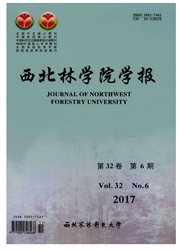

 中文摘要:
中文摘要:
探讨了运用可见/近红外光谱分析技术建立巴山木竹蛋白质定量分析模型的可行性。运用传统方法实测了样品蛋白质含量,并运用光谱分析软件建立了样品蛋白质含量与光谱数据的PLS与PCR校正模型。基于主要性能指标对不同光谱预处理与建模方法进行评价,筛选出最优校正模型并使用验证集样品对校正模型的预测能力进行了验证。巴山木竹竹叶与竹秆蛋白质最优校正模型的决定系数(Rc^2)分别为0.935和0.862,交叉验证均方差(RMSEC)分别为0.351和0.172;经外部验证,预测模型决定系数(Rp^2)分别为0.916和0.874,验证集样品的相对分析误差(RPD)分别为3.562和2.840。表明应用可见/近红外光谱分析技术可以实现巴山木竹蛋白质含量快速检测。
 英文摘要:
英文摘要:
The feasibility to establish quantitative analysis models of the protein in Bashania fargesii by applying visible/near-infrared (Vis/NIR) spectroscopy was studied. The content of protein in each sample was analyzed by the Kjeldahl method and calibration models of PLS, PCR between protein content and spectral data were established by spectrum analysis software. The optimal calibration models were selected by the main performance indexes, different spectrum datum pretreatment methods were also studied and compared. Prediction abilities of optimal calibration models were tested by the samples in validation set. The correlation coefficients (Rc^2) of the calibration models of the protein in B. fargesii leaves and culms were 0. 935 and 0. 862, respectively. The root-mean-square error of calibration (RMSEC) were 0. 351 and 0. 172, respectively. The correlation coefficients of prediction (Rp^2) were 0. 916 and 0. 874,RPD (SD/RM- SECV) of validation set were 3. 562 and 2. 840, both were greater than 2.5. The results indicated that Vis/ NIR spectroscopy could be used in the fast determination of the protein in B. fargesii.
 同期刊论文项目
同期刊论文项目
 同项目期刊论文
同项目期刊论文
 期刊信息
期刊信息
